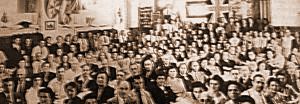A More Liberal Attitude
Maltese Club of S. California, June 1966 President Kennedy's attitude towards immigration had given rise to a hope that racial considerations will not be as preponderant as they had been in the past. Shortly before his life was tragically cut short by murderous bullets in Dallas, Texas, on November 22,1963, Kennedy had made his mind on immigration quite clear: "In matters of immigration the highest priority should go to those with the greatest ability to add to the national welfare, no matter where they were born".(22) The Report on Emigration of the Maltese Government for 1961 echoed the expectations of the times. It said that Senator Kennedy had fourteen years of experience in championing a more liberal attitude in his country's policy towards immigration. It was also significant that in April Congressman Walter, co-author of the MacCarran- Walter Act, had himself presented , amendments. At first his efforts were rebuffed. In 1962 Mr Walter was in Geneva where he met Dr Alexander Cachia Zammit, Malta's minister for emigration. Dr Cachia Zammit urged Mr Walter to consider the plight of those who were detained in Malta while their relatives anxiously waited for them in the U.S.A. Mr Walter assured Dr Cachia Zammit that on his return to Washington he will press the case of those Maltese referred to by Malta's representative. (23) On October 3, 1965, President Lyndon Johnson put his signature to the Immigration and Nationality Act which effectively annulled the MacCarranWalter Act of 1952. It transpired that a period of at least three years was needed before the full effects of the new amendment could be felt. After President Johnson's intervention emigrants to the U.S.A. were enabled to avail themselves of unused quotas. The old insistence on ethnic considerations was dismissed for a new system which worked on eight category preferences which took into consideration the value of family reunion and the qualification and skills of the applicants. President Johnson signed the amendment on Liberty Island in New York harbour, a place obviously chosen for its significance to the millions which had arrived in this spot from so many diverse countries. Mr Loreto Tabone from Gozo, who was then the president of the Maltese American Benevolent Society, was invited for the signing ceremony and was given a commemorative pen by the President of the U.S.A. (24) Such restrictive measures had had a considerable erfect on the numbers of Maltese who were able to emigrate to the U.S.A. When Maltese were leaving in their thousands for Australia, U.K., and Canada, the figures for Maltese emigrants who were able to leave for the U.S.A. between 1962 and 1965 speak for themselves: 1962: 76; 1963: 92; 1964: 87; 1965:84. Because of the Johnson Amendment the figures went up to an average of two hundred a year. They were never to exceed the three hundred mark. What was then significant was the fact that for the first time in American immigration history the U.S. Government allowed financially assisted immigrants to enter the country. (25) Another interesting development was the arrival in Malta of two representatives from the American firms Hickey-Freeman and William B. Kessler. Forty Maltese workers were recruited. Such recruiting by American firms was not allowed before but this was made possible by the application of the sixth preference category of the new legislation. (26) There were those who somewhat prematurely had envisaged an increase in this form of recruiting of Maltese workers for American firms. In fact arrangements were made so that members of the staff of the Maltese Consulate in New York could meet every group of Maltese arrivals and to offer them any assistance needed. (27) Another amendment to the Immigration and Nationality Act was carried in 1976. This basically removed any special preference allowed to certain areas of immigration. Immigrants from the two hemispheres were equally treated. In 1990 another Immigration Act was passed which was hailed by the White House as the most comprehensive reform of immigration laws in sixty-six years. The Act aimed at increasing the immigration of skilled individuals to meet the country's economic needs while retaining the nation's commitment to family reunion. (28) Maltese interest in the Acts of 1976 and 1990 was largely academic. From 1976 onwards emigration from Malta declined sharply. Such a decline was particularly evident in the emigration statistics for the U.S.A. In 1990 the total figure for emigrants from Malta was that of 160 persons. Those who chose to go to the U.S.A. were only in double figures. This decline was not due to harsh selective criteria but it was simply due to the fact that emigration was no longer important. Source: The Safety Valve (1997), author Fr Lawrence E. Attard, Publishers Enterprises Group (PEG) Ltd, ISBN 99909-0-081-7
    
| 

![]() .
.